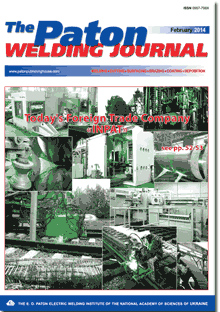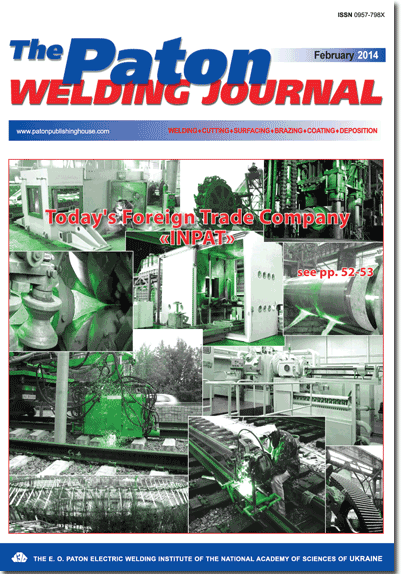| 2014 №02 (07) |
DOI of Article 10.15407/tpwj2014.02.01 |
2014 №02 (02) |

The Paton Welding Journal, 2014, #2, 2-11 pages
RESISTANCE TO COLD CRACK FORMATION OF HAZ METAL OF WELDED JOINT ON HIGH-STRENGTH CARBON STEELS
A.A. GAJVORONSKY
E.O. Paton Electric Welding Institute, NASU. 11 Bozhenko Str., 03680, Kiev, Ukraine. E-mail: office@paton.kiev.ua
Abstract
Influence of preheating temperature and heat input during surfacing on change of delayed fracture resistance of HAZ metal on high-strength steel at variation of carbon content in it from 0.55 to 0.75 % was investigated. Effect of carbon content in steel on indices of critical stresses at HAZ metal delayed fracture was evaluated by Implant tests. Influence of a cooling rate on nature of metal fracture and typical rupture zone and parameters of structural constituents were studied and determined using the methods of scanning electron microscopy. It is determined that HAZ metal is predisposed to the delayed fracture in electric arc surfacing due to formation of quenched structures with high dislocation density and internal stresses in area of overheating. Increase of cooling rate and carbon content in steel promotes rise of fracture susceptibility and decrease level of critical stresses to 0.07s0.2. Formation of more plastic structures at reduction of the cooling rate in 600-500 °C temperature interval promotes increase of the delayed fracture resistance of HAZ metal on high-strength carbon steels to scr У 0.45s0.2 level. A diagram of effect of carbon content in steel on HAZ metal resistance to the delayed fracture was plotted in form of w6/5 = f(C). It is determined that the process of delayed fracture in HAZ metal on steel with carbon content not more than 0.60 % can be prevented at cooling rate w6/5 not more than 16 °C/s, w6/5 Г 8 °C/s with 0.60-0.65 % C and w6/5Г 5°C/s with 0.65-0.75 % C. Under such conditions, the structures, having sufficiently high capability to microplastic strain without microcrack generation, are formed in the metal of HAZ overheating area. 18 Ref., 2 Tables, 11 Figures.
Keywords: electric arc surfacing, high-strength carbon steel, HAZ, preheating, heat input, delayed fracture, structure, rupture
Received: 11.10.13
Published: 28.02.14
References
1. Alekseeva, L.E., Sarrak, V.I., Suvorova, S.O. et al. (1975) About two ways of residual microstress relaxation in martensite of steel. Metallofizika, Issue 61, 79-84.
2. Sarrak, V.I., Filippov, G.A. (1976) Delayed fracture of steel after tempering. Fiz.-Khimich. Mekhanika Materialov, 2, 44-54.
3. Panasyuk, V.V. (1991) Mechanics of quasibrittle fracture of materials. Kiev: Naukova Dumka.
4. Shorshorov, M.Kh. (1965) Physical metallurgy of welding of steel and titanium alloys. Moscow: Nauka.
5. Makara, A.M., Mosendz, N.A. (1971) Welding of high-strength steels. Kiev: Tekhnika.
6. Makarov, E.L. (1981) Cold cracks in welding of alloyed steels. Moscow: Mashinostroenie.
7. Filippov, G.A., Sarrak, V.I. (1980) Local hydrogen distribution and internal stresses in structure of quenched steel. Fizika Metallov i Materialovedenie, 49(1), 121-125.
8. Sterenbogen, Yu.A. (1986) Some factors determining the HAZ metal resistance of martensite steels to cold cracking. Avtomatich. Svarka, 6, 5-8.
9. Kasatkin, O.G. (1994) Peculiarities of hydrogen embrittlement of high-strength steels in welding. Ibid., 1, 3-7.
10. Pokhodnya, I.K., Shvachko, I.V. (1997) Physical nature of hydrogen induced cold cracks in structural steel welded joints. Ibid., 5, 3-12.
11. Shvachko, V.I., Ignatenko, A.V. (2007) Model of transportation of hydrogen with dislocations. The Paton Welding J., 2, 24-26.
12. Skulsky, V.Yu. (2009) Peculiarities of kinetics of delayed fracture of welded joints of hardening steels. Ibid., 7, 12-17.
13. Ignatenko, A.V., Pokhodnya, I.K., Paltsevich, A.P. (2012) Dislocation model of hydrogen-enhanced localizing of plasticity in metals with bcc lattice. Ibid., 3, 15-19.
14. Gajvoronsky, A.A., Poznyakov, V.D., Sarzhevsky, V.A. et al. (2010) Influence of thermodeformational cycle of hardfacing on the structure and properties of railway wheels at their reconditioning. Ibid., 5, 15-18.
15. Gajvoronsky, A.A., Zhukov, V.V., Vasiliev, V.G. et al. (2014) Structural changes in overheating zone of HAZ metal of railway wheels in arc surfacing. Ibid., 1, 13-19. https://doi.org/10.15407/tpwj2014.01.02
16. Gajvoronsky, A.A., Poznyakov, V.D., Markashova, L.I. et al. (2012) Influence of deposited metal composition on structure and mechanical properties of reconditioned railway wheels. Ibid., 8, 16-22.
17. Gajvoronsky, A.A. (2013) Influence of diffusible hydrogen on delayed cracking resistance of high-carbon steel welded joints. Ibid., 5, 14-20.
18. Poznyakov, V.D., Kiriakov, V.M., Gajvoronsky, A.A. et al. (2010) Properties of welded joints of rail steel in electric arc welding. Ibid., 8, 16-20.
Suggested Citation
A.A. GAJVORONSKY (2014) RESISTANCE TO COLD CRACK FORMATION OF HAZ METAL OF WELDED JOINT ON HIGH-STRENGTH CARBON STEELS. The Paton Welding J., 02, 2-11.The cost of subscription/purchase order journals or individual articles
| Journal/Currency | Annual Set | 1 issue printed |
1 issue |
one article |
| TPWJ/USD | 384 $ | 32 $ | 26 $ | 13 $ |
| TPWJ/EUR | 348 € | 29 € | 24 € | 12 € |
| TPWJ/UAH | 7200 UAH | 600 UAH | 600 UAH | 280 UAH |
| AS/UAH | 1800 UAH | 300 UAH | 300 UAH | 150 UAH |
| AS/USD | 192 $ | 32 $ | 26 $ | 13 $ |
| AS/EUR | 180 € | 30 € | 25 € | 12 € |
| SEM/UAH | 1200 UAH | 300 UAH | 300 UAH | 150 UAH |
| SEM/USD | 128 $ | 32 $ | 26 $ | 13 $ |
| SEM/EUR | 120 € | 30 € | 25 € | 12 € |
| TDNK/UAH | 1200 UAH | 300 UAH | 300 UAH | 150 UAH |
| TDNK/USD | 128 $ | 32 $ | 26 $ | 13 $ |
| TDNK/EUR | 120 € | 30 € | 25 € | 15 € |
AS = «Automatic Welding» - 6 issues per year;
TPWJ = «PATON WELDING JOURNAL» - 12 issues per year;
SEM = «Electrometallurgy Today» - 4 issues per year;
TDNK = «Technical Diagnostics and Non-Destructive Testing» - 4 issues per year.


